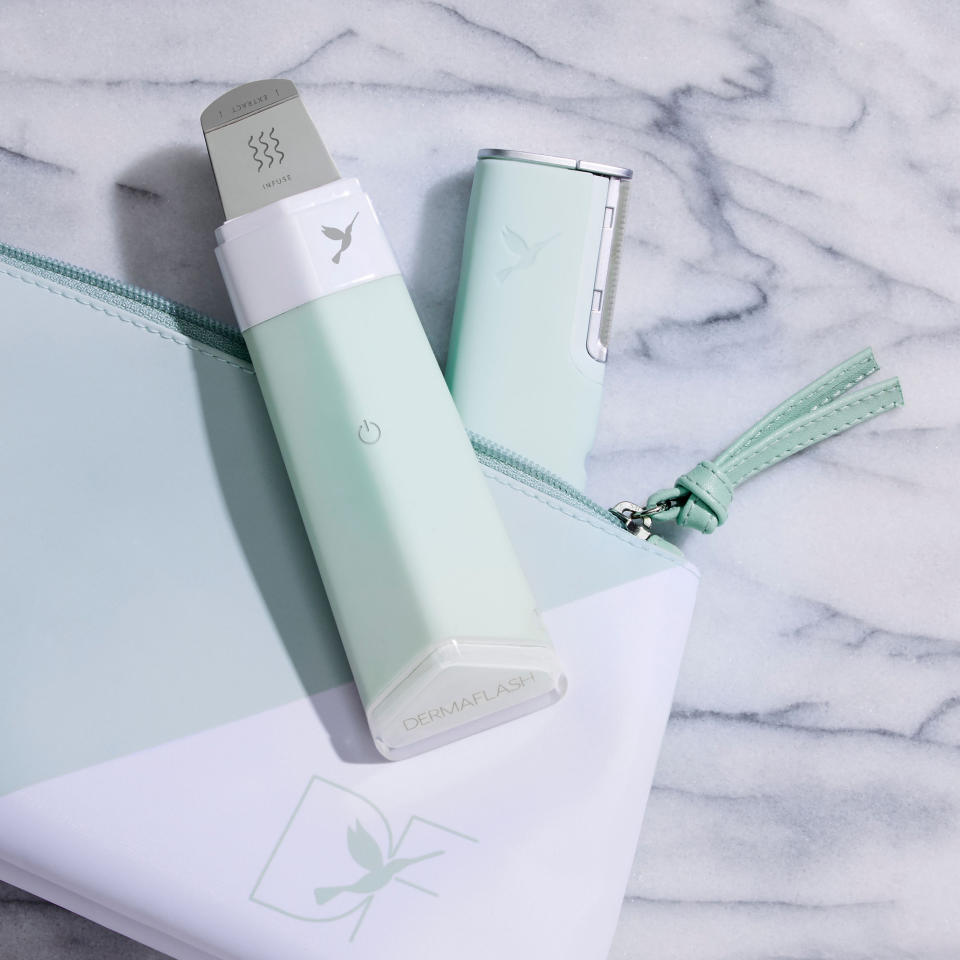Read this before you try those crazy-popular at-home extraction tools
We all live for a detoxifying facial—there’s really nothing some extractions (our personal fave) and glycolic acid can’t fix. However, while a 30-minute facial treatment is always a treat for our pooped-out complexion, there’s no denying that getting facials on the regular can quickly add up. And sure, there are at-home devices that promise to cut down on pricey salon visits, but there hasn’t been a gadget on the market that claims to match the pore-cleansing treatments we get at the derm’s office, until now.
Thanks to industry giants like Rodan + Fields and DERMAFLASH, at-home extraction tools are now a thing. In just the past year, both brands have unveiled blackhead-removing tools that allegedly deep-cleanse your pores in minutes. While these gadgets can indeed cost just as much as (or even more than!) a medical-grade facial, the vice president of product development for Rodan + Fields, Sumita Butani, says they are cost-efficient in the long run, since they can spare you from costly dermatologist visits in the future.
But are they safe?

“The Rodan + Fields Pore Cleansing System ($260) mimics the brand’s patented in-office treatment that uses a combination of pressure and suction to cleanse the pores,” Butani tells HelloGiggles. “Regular use of this system brings the benefits of a dermatology office, without even having to leave your house.”

Similarly, DERMAFLASH founder, Dara Levy, says that the brand’s new DERMAPORE ($99.95) device is similar to the machine used by aestheticians at spas, adding that it safely removes built-up dirt and oil. She says that this device uses special ultrasonic technology, which allows your serums, oils, and creams to penetrate deeper into the skin.
But, with all new products, there’s always room for doubt, especially since many skin-boosting gadgets tend to make a ton of unproven claims. To find out if at-home extraction tools like these are actually worth your time and money, we tapped six board-certified dermatologists to weigh in on this budding product trend. Here’s what they want you to know:
Extraction Tools Should Always Be Used Carefully.
Although extraction tools may seem like a godsend for oily and acne-prone skin types, Marisa Garshick, M.D., a board-certified dermatologist in New York City, suggests that these products should always be used with caution (you’ll never want to use them in combination with any harsh scrubs or skin-irritating chemical exfoliants), especially if your skin also happens to be on the sensitive side.
And while Dr. Garshik acknowledges that some of these tools can help unclog pores, she says that it’s equally important to not use them too vigorously or frequently, as it could cause unwanted damage (more on that below!) to your skin. In other words, please go gentle.
Using Extraction Tools Could Lead To More Blemishes.
Although the goal of these cleansing tools is to remove dirt, debris, and bacteria, Peterson Pierre, M.D., a California-based dermatologist, says that going after pimples and blackheads too aggressively with an extraction tool can cause more problems than it fixes.
“Bacteria and pus in the pimple can go into the skin rather than just come out, which can cause greater inflammation and irritation,” Dr. Pierre tells HelloGiggles. This, he says, can cause tears in the skin and can even lead to cyst formation. Yikes!
Extraction Tools Can Strip Your Skin Of Essential Moisture.
Because these tools either scrape your skin or suction debris out of your pores, there’s a risk of potential moisture loss, suggests Rhonda Klein, M.D., a Connecticut-based dermatologist. She says that extraction tools can leave the skin drier than before, making it incredibly important to rehydrate the skin immediately after using one.
“These devices can overly strip the skin of moisture, so it’s important to follow up with hydrating humectant after you use it,” Dr. Klein explains. “I’d recommend a product with hyaluronic acid, which is non-comedogenic.”
The Ultrasonic Waves In Some Extraction Tools May Not Be Powerful Enough To Actually Work.
While ultrasonic pore-cleansers claim to use ultrasonic waves that loosen and unclog debris, Caren Campbell, M.D., a San Francisco-based dermatologist, says she’s wary of these hefty claims.
“I don’t think these waves penetrate the skin (or provide enough vibration) to loosen dirt and debris from the pore,” Dr. Campbell tells HelloGiggles. “Heating skin is never a good treatment option as it can cause worsening of broken blood vessels and redness, and it can also worsen conditions like rosacea and melasma.”
Keeping Your At-Home Extraction Tools Sterile May Be An Issue.
Cleanliness is another concern surrounding extraction tools. Morgan Rabach, M.D., a dermatologist in Manhattan, suggests that at-home products won’t be able to be cleaned properly like medical-grade office tools, which can be bad news for your skin.
“At the dermatologist office, we sterilize every single extractor by heating it to hundreds of degrees,” Dr. Rabach says. “Wiping these with a little rubbing alcohol is certainly not going to do the trick.”
There Are Gentler Alternatives.
Dr. Rabach does acknowledge that the suction extraction tool may help unclog pores, however, she stresses the importance of remembering that the risks of contamination and damage to the skin outweigh the benefits—and there are much safer alternatives.
Instead of turning to pricey skin-care gadgets, she suggests using safer products (like masks, physical exfoliators, and over-the-counter chemical exfoliators) that permeate the skin.
Bottom Line—Leave Extractions To The Pros
Although the idea of removing whiteheads and blackheads with futuristic tools may seem very tempting, Dr. Pierre urges you to leave these types of extractions to the pros.
“While these tools are far more effective than a washcloth or pore cleansing strips, nothing replaces good technique,” he explains. “See a dermatologist regularly to develop a regimen to prevent pimples from happening, and get medical-grade facials to deal with them when they do occur.”

